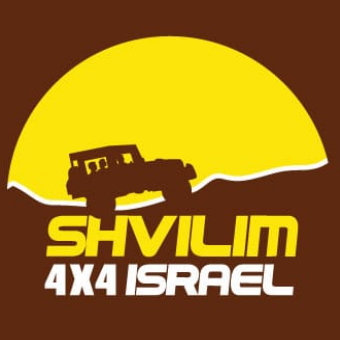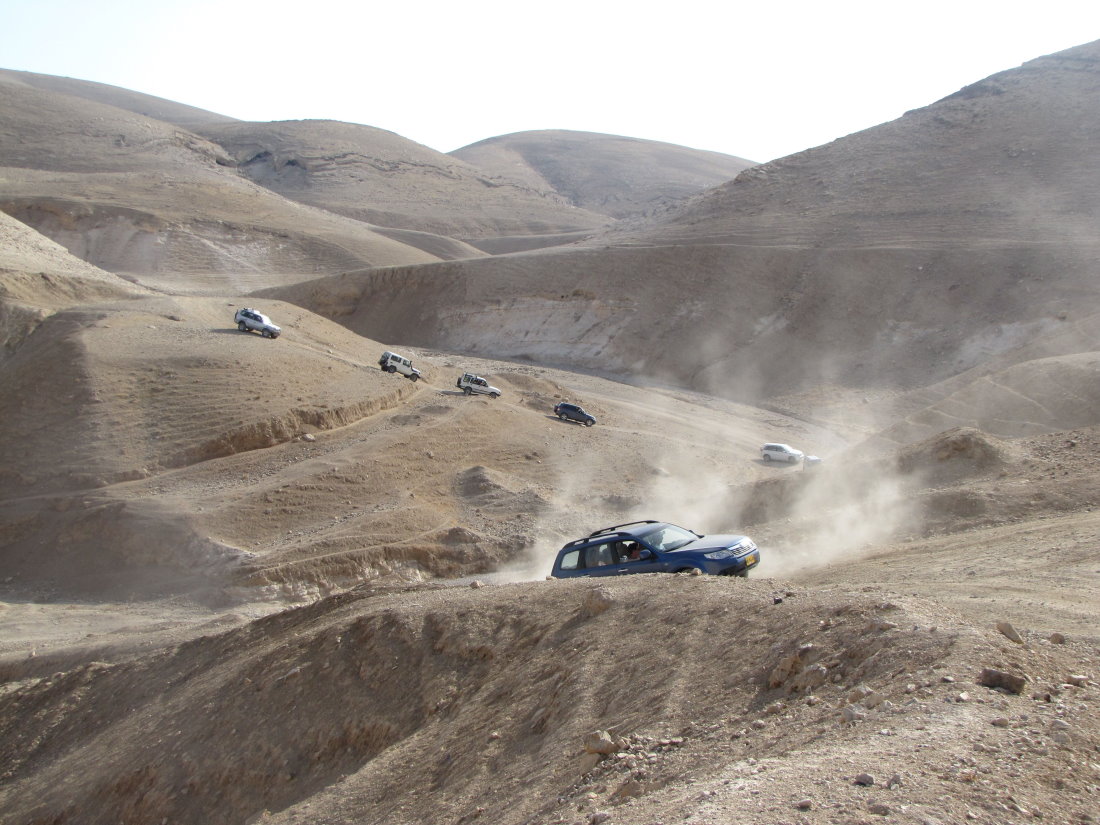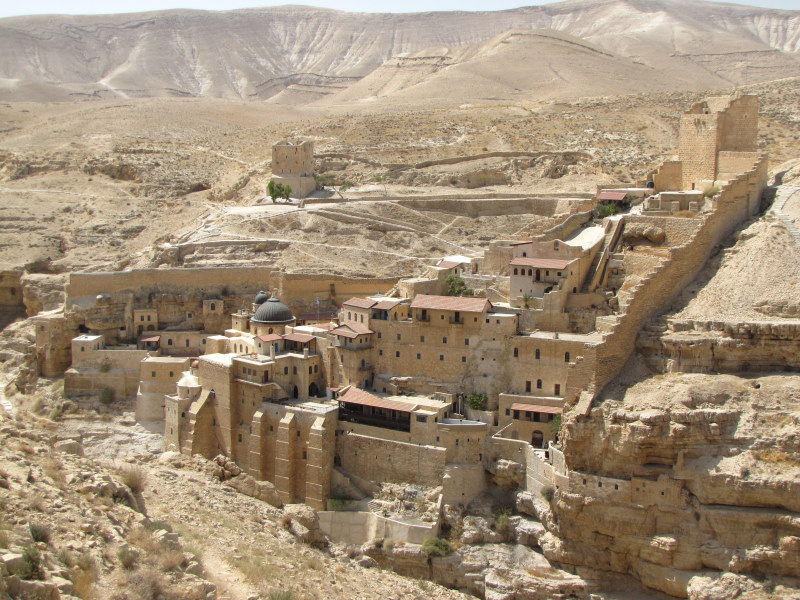The most beautiful desert in the world
Judean Desert, from Nabi Musa to Marsaba Monastery and Jabal Montar
Area: North Judean Desert
Difficulty level: For tough off road vehicles - easy. For soft off-road vehicle - medium.
Starting point: The gas station at Mishor Adumim.
End point: The gas station at Mishor Adumim.
Length of the route: about 30 km.
Travel time: 7-5 hours.
Recommended season: All year round.
The famous poet Yehuda Amichai, not long before his death, asked his friend, the writer Meir Shalev, who is also an experienced off road enthusiast, to take him on a trip in the Judean Desert. Its no wonder, because there is nothing like the Judean Desert. The smallest desert in the world is perhaps also the most beautiful.
This trip route is the classic route for the northern Judean Desert. A fascinating eventful trip that passes through the must-see sites: the Nabi Musa Mosque, the observation point across the Marsaba Monastery and the climb to the summit of Mount Montar. The track is suitable for any rugged off-road car, as well as many of the soft off-road vehicles.
We drive about 12 km from the starting point on road number 1 in the direction of the Dead Sea (east) and from there we turn right according to the signs "to Nabi Musa". After a short time, white domes suddenly become visible. This is the Nabi Musa mosque.
We pass Nabi Musa and then continue on the bridge over the Og River - a nice spot for flood-hunters. After a few kilometers we go off road to the right. We cross a few creeks and after a few kilometers ahead the road enters a creek trail that leads into "Ma'ale Marsaba" - the ascent to the Marsaba monastery. The road is not particularly difficult but when a fork is revealed later on it is advisable to take the easier right path. The Marsaba can be seen after only a few kilometers at an observation point that we reach on a small detour. The observation point is right in front of the Marsaba which is a beautiful place. Ancient as it is, seeing it never gets old - even if you visit the place many many times.
We return from the observation point detour and navigate our way up the Montar mountain - which is the most serious driving challenge on this trip. Those who prefer to give up the challenge of Ma'ale Montar, can drive on a dirt road that bypasses it on the left and after 400 meters turn right and right towards the summit of Mount Montar which will be seen right in front - in the easterly direction.
When we reach the top of Mount Montare, we stop at the plain just in front of the summit itself and do not ascend with the vehicle right up.
Mount Montar (Jabal Montar) is the highest mountain in the Judean Desert - 524 meters above sea level. It is regarded as what was known as the mountain of Azazel - from which the yearly Yom Kippur custom was to throw a scapegoat to atone for the sins of the people of Israel.
Remains of a fortifications from the First World War can be seen here. It used to be the headquarters of the Anzak Division, whose soldiers came from Australia and New Zealand to fight against the Turkish army.
From the Montar you can see Jericho and its surroundings, the Dead Sea, the Moab Mountains, the villages around Bethlehem, Herodium (a truncated mountain in a southwesterly direction), the settlement of Kedar (red roofs in a northwesterly direction), the city of Ma'ale Adumim and of course, Jerusalem.
From Mount Montar to the end of the route, we navigate through a complex and interesting trail, passing carefully on different types of paths - either between dirt embankments, or creeks, or over ridge lines. There are steep ascents and descents and there are parts where it is important to stay calm and not panic but to continue driving at a steady pace. The trail is beautiful and varied.
Nabi Musa Mosque:
Here, according to Muslim tradition, is buried the Prophet Moses ("Musa" in Arabic). According to Jewish tradition, Moses was not allowed to enter the Promised Land and his burial place, in the eastern part of the Jordan, is unknown. As it is written:
"And the Lord said to him, This is the Land I swore to Abraham, to Isaac, and to Jacob, saying, 'I will give it to your offspring.' I have let you see it with your eyes, but you shall not cross over there.
And Moses, the servant of the Lord, died there, in the land of Moab, by the mouth of the Lord.
And He buried him in the valley, in the land of Moab, opposite Beth Pe'or. And no person knows the place of his burial, unto this day." (Devarim - Deuteronomy chapter 34 4-6)
The structure of the mosque was built in 1269 by the Mamluk Sultan Beavers. Over the years, various wings and structures were added to the mosque to serve the many pilgrims who visited the tomb each year. Every year, on the Jewish week of Passover, the holiday of Nabi Musa - Ziarat Nabi Musa is celebrated. During the British Mandate (1948-1917) the holiday had a distinctly anti-Zionist political character. Violent processions marched towards Jerusalem. This practice ceased after the establishment of the state.
The tomb complex currently covers an area of about 5,000 dunams. Outside the walls of the compound is a large cemetery, where to this day Bedouins from all over the Judean Desert are buried.
A rehab center for Muslim addicts operates in the northern part of the building. The rooms house between ten and fifteen drug addicts, in various stages of rehab.
Marsaba Monastery
The monk Sabas came to Israel about 1,500 years ago and began practicing his ascetism at a cave located on a cliff on the western side of the Kidron River. The years passed and around Sabas, who was probably a charismatic person, more monks gathered and came. They settled in other caves and gradually various structures were built on the site and a central monastery was established. Sabas was a key figure in the celibate movement of the Judean Desert. In the 94 years of his life he established many monasteries. Among them the Marsaba is the most important one.
Marsba is a devout Greek Orthodox monastery, one of the few that remained and survived. Today about 20 monks live in the monastery. It is not connected to water supply system nor to electricity or telephone networks. The monks do not read newspapers and do not have active Facebook accounts. The monastery is sustained by donations.
The monks' daily routine begins actualy in the middle of the night. They get up at midnight (in the winter - at two in the morning), pray for four to five hours and then go to have breakfast: a slice of cake or bread and a cup of coffee. They are then dispersed for maintenance and cleaning works throughout the monastery. At 10:30 they gather for lunch, which is actually the only meal of the day. The menu consists of bread, rice, cooked vegetables, water and a little wine. On holidays and Sundays, a modest dinner is also served and a slice of fish is added to the menu.
"Women,meat and apples, are not allowed in the monastery. Women - so that the monks do not have any chance to experience any temptation; meat - because it increases the hormones and with them the lust; apples - because according to tradition the holy Sabas worked on a day of fasting in the monastery garden, and an apple that winked at him from the trees almost enticed him to break his fast. That day he decided that there would be no more tempting apples in the monastery. For the pilgrims who come to the monastery a special tower was erected next to it. In the old days women could lodge in the tower, but today they can only overlook the monastery." (source: "Another Journey", an article by Dancho Arnon).




